gobble, gobble, gone: perfectly roasted turkey
There are several occupational hazards to being a chef. One hazard is the repetitive slumping over counters and stovetops which sometimes sends me to the chiropractor, as it did again this week. Looking at my crooked frame, he asked me what I did to get myself in this mess. “I am a chef,” I replied. “That is funny,” he said, “I was just going to say that it smells like Thanksgiving in here.” Just then I got a whiff of my own hair which smelled like . . . well, roasted turkey. Occupational hazard number two: smelling like the food you are cooking.
The turkey smell made me think of the first time I cooked a Thanksgiving turkey. I was in college, wanting to demonstrate my culinary and domestic enthusiasm for my boyfriend and his parents. I am paraphrasing, but I believe it was Thomas Edison who said that that he had not failed but he “found 10,000 ways that [wouldn’t] work.” That Thanksgiving produced many turkey discoveries.
My first discovery was that purchasing a 22 pound turkey for 6 people is just too much turkey. My second discovery was that it takes a long time for a 22 pound turkey to thaw. I could not get it brined in time for the planned meal, nor could I defrost it fast enough. This massive, flightless poultry-iceburg was too large for my tiny apartment kitchen sink and I was forced to defrost it under cold, running water in the bathtub (of course I left it in plastic wrapping but the whole thing, image and all, was just wrong). However, this turkey’s Calgon moment was not the last of the trouble this bird would cause me for when it was time to pull it from the oven, the heavy bird tipped in the roasting pan, the pan fell forward, the turkey landed on the open oven door and turkey sucs, the grease, and the roasting liquid gushed all over the oven, the oven door, and the kitchen floor. Major mishap for me but manna from Heaven for my Yorkshire terrier who jumped in the lake of turkey juice lapping it up, and then ran throughout the apartment tracking her greasy paws on the 80’s white (white!) carpet, and bouncing on the furniture to allude capture.
It was a culinary and housekeeping disaster: apartment a greasy mess; gravy nonexistent; dog vomiting from the rich turkey sucs; and overcooked, mushy or dry side dishes (as my attention was focused on salvaging the turkey and cleaning up the mess). I laugh about it now and I also know that I am not alone. Everyone has a turkey gone bad story. Overcooked. Undercooked. Turkey frozen in the middle. Turkey on fire. After over twenty years of practice, culinary school, and teaching others, I have discovered many ways that do not work and things that do. Making sure your Thanksgiving turkey turns out just right was the inspiration for this week’s simple pleasure: perfectly roasted turkey.
turkey 101
how big a turkey should I buy?
What size turkey to buy depends upon the number of guests you are feeding. Whole turkeys are sold in weight ranges (i.e., 12-14, 15-16, 17-18, etc.). Rather than memorizing turkey sizes and how many guests that will feed, calculate 1 ½ pounds per person when purchasing a whole turkey (for a boneless breast, plan on ½ pound per person). For example, for 8 guests you need a whole turkey that weighs 12 pounds.
I would not purchase a turkey larger than 16 pounds. They take a long time to roast and larger turkeys are less flavorful and can be tough (I am talking about their meat, not their personalities). If you are feeding a lot of people, you are better off roasting two smaller turkeys.
If the turkey is frozen, leave it in the plastic wrap and place it in a large bowl or a rimmed tray on the bottom shelf of your refrigerator (you do not want raw turkey juice to drip on your produce).
brining:
why? when? how long ? and how ?
Brining is soaking a meat protein in a salt-water based solution. All quality restaurants brine and they brine everything from cuts of meat and fish to whole turkeys because brining improves the flavor and texture of meat.
In the most simple terms, the salt in the brine dissolves the protein structure of the meat allowing the meat to absorb the water solution. This absorption will impart the flavor of the brine to the meat and make the turkey juicier than a turkey that was not brined because the water retention means the turkey will have more moisture to loose in the roasting process.
You should not brine a turkey that has been treated or infused with a salt solution such as: (1) a kosher turkey, (2) a pre-brined turkey, or (3) a self-basting turkey. If you do, your turkey will be too salty.
How long to brine depends upon the size of the meat protein. Whole turkeys should be brined for 8 to 12 hours. I always brine overnight but never longer than that. Before you brine, remove the neck, giblets, liver and set aside (use these for your gravy and stuffing). When your turkey is finished brining, rinse the turkey well and pat it dry with paper towels. Throw away the brine (do not use it for something else).
There are two types of brine: a “simple” brine which is a salt/sugar/water solution and a “complex” brine which is a simple brine with the addition of other flavors such as spices, herbs, citrus, garlic, and even juice or alcohol. If you do not have time to make a complex brine, just do a simple brine. It is better than no brine at all.
The general formula for a simple brine is 1 cup of kosher salt (or ½ cup table salt because it is less dense) and ¼ cup granulated sugar for every gallon of water (1 gallon is equal to 16 cups or 4 quarts). Generally you need a 1½ to 2 gallons of water to brine a whole turkey.
oven-ready:
how to prepare the turkey for a successful roast
You would not leave the house without your shoes or keys. Similarly, your turkey must be “ready” for its oven adventure. When it comes to roasting a turkey, the majority of the work lies in preparing it for the oven which will ensure that the turkey is moist, flavorful, and evenly cooked.
season and air dry
After you have brined the turkey and rinsed it, generously season the skin and the cavity with salt and pepper. Let it dry in the refrigerator for 1 day, covered only with a paper towel. This will dry the skin and make it crisp when roasted.
barding
Barding is adding a layer of fat to a lean food product to keep it moist and give it flavor. I am not going to suggest that you wrap the turkey in bacon but I am going to insist that you place pats of butter between the breast skin and the breast meat. I do not know of one chef who does not do it. It is an easy way to keep the breasts from drying out as well as adding flavor.
stuffing
I do not place my stuffing in the turkey cavity because generally I have to make so much it would not fit in the cavity and it increases the roasting time, taking oven space. However, like a bouquet garni in simmering soup, adding fresh herbs and vegetables into the cavity of the turkey will give the turkey additional flavor.
trussing
The purpose of trussing is to keep the turkey wings and legs from separating from the turkey and burning. You can truss with kitchen twine. However, if you do not have twine, use the extra skin and fat at the turkey tail to secure the legs (or use the metal fasteners around the leg joints which now come with most turkeys). For the wings, you can tuck the wings under themselves and inward under the body.
roasting rack
Roasting surrounds your food product with dry heat. I recommend a “V” shaped rack as it secures the turkey (from tipping) and usually lifts the turkey high enough so the heat gets under the turkey and around the sides of the roasting pan.
However, your roasting rack does not have to be metal. You can make a rack out of mirepoix just as long as it is high enough to roast the turkey bottom and sides. This not only makes your clean-up easier, but the roasting vegetables will infuse the turkey drippings and broth which will be wonderful for your gravy. If you use a traditional metal rack, place chopped vegetables on the bottom of the roasting pan.
how do I roast the turkey ?
Upside down, right side up, sideways, or cut up! The challenge in roasting poultry lies in the very nature of the meat itself: the breast meat is very lean and cooks faster than the leg and thigh meat which is less lean. The problem is that in an effort to cook the back end, the front end dries out. To compensate for this situation, people recommend roasting the turkey in positions other than right side up (as discussed). If you add butter under the skin, you really have eliminated the need for altering the turkey’s position and can keep it in place breast side up.
how long to roast it?
Roasting times are based upon the size of the turkey and whether the turkey is stuffed or unstuffed. Roasting times are guidelines only and you should use them only for the purpose of organizing the preparation of your side dishes and for an approximate meal time.
It is unnecessary to start roasting the turkey at a high temperature and then lower the temperature. This method is for the purpose of browning a food product that because of its size will not be in the oven long enough to gain the desired color without overcooking in the process. However, for home cooks I recommend starting the oven at 400 degrees Fahrenheit to compensate for the loss of oven heat which occurs while getting the turkey situated in the oven. After 15 minutes, reduce the temperature to 350 degrees Fahrenheit and keep it there. It is a good temperature for turkeys (unless they are over 18 pounds…) and it is also a perfect temperature for your side dishes. At 350 degrees Fahrenheit, an unstuffed turkey weighing 12-14 pounds will take approximately 3 hours.
Make sure that your turkey has come to room temperature before you put it in the oven. I suggest pulling it from the refrigerator 2 hours prior to placing it in the oven.
basting:
what is it ? why do it ? and when ?
Basting is taking a liquid and/or drippings from the bottom of the roasting pan and pouring it over the turkey while it roasts. There are bulb basters made just for this; however, you can use a large metal spoon.
There is disagreement even among chefs as to whether basting crisps the skin. That aside, basting does coat the food with flavor and cools the food, slowing the cooking process which helps the breast meat from drying out). I recommend basting every 30 minutes for the first 2 hours. If you baste after that you will make the skin soggy.
browning the turkey
About 1 hour prior to the projected end cooking time… remove the aluminum foil to brown the turkey. You want a deep brown color. However, it if looks like the turkey is going to burn, loosely place the foil back over the turkey.
when is it done?
I hear it from students all the time: when is it done? How long to I cook it? People want to know exactly what time to take the item out of the oven. Sorry, it does not work like that and if you rely on cooking times like a holy grail, rather than a general guideline, you will be disappointed and so, too, will your guests.
Cooking is like child rearing; you cannot predict things with clock certainty. Just because your child is one year old does not mean that s/he is going to walk. If they are not ready to walk, they are not ready. Similarly, a turkey is ready to be removed from the oven when it is ready, not when your timer goes off.
You can tell the turkey is ready to be taken from the oven when the skin is golden brown, your kitchen smells like turkey, and the juices at the thigh run clear when the skin is pierced. The best way to determine whether your bird is done is to use a meat thermometer. It is recommended that the breast meat register 165 degrees Fahrenheit and the thigh meat register 175 degrees Fahrenheit before consumption. However, this does not account for carry-over cooking. Accordingly, take the turkey out of the oven when the breast meat registers 161-162 degrees Fahrenheit and the thigh meat registers 171-172 degrees Fahrenheit.
give it a rest !
When you remove the turkey from the oven, let the turkey rest for 30 minutes. This rest period is critical for two reasons: it allows for carry-over cooking and redistribution of the turkey juices.
I cannot emphasize this enough: the heat in the item you are cooking does not magically disappear once you remove it from the heat source. On the contrary, the meat retains the oven heat and that retention will continue to cook the meat even after it is removed from the heat source. This is called “carry-over” cooking. One of the primary reasons that Thanksgiving turkeys end up as dry as a pilgrim’s shoe is that cooks forget about carry-over cooking and wait for the turkey to reach consumption temperatures before they remove it from the oven. However, if you take the turkey out of the oven prior to reaching those temperatures, the carry-over cooking will continue to cook the meat for another 3-4 degrees and you will end up exactly where you want to be.
Allowing the turkey to rest not only permits carry-over cooking to do its magic, but it allows the juices to be reabsorbed and redistributed in the meat. Meat tenses when it is subjected to heat, and when the muscles contract, juice is expelled from the meat (you can see it trapped under the skin when you remove the turkey from the oven). Once you take the turkey away from the assaulting oven, the meat relaxes and re-absorbs the juice. If you cut into the flesh while it is still tense, all of the expelled juice will be lost and your turkey will be dry. Use the 30 minutes while the turkey is resting to finish or re-fresh your side dishes and make your gravy.
***
The recipe is in the companion post for your printing ease.
Wishing all of you a very Happy Thanksgiving and un très bon appétit !
LM
Tags: Air dry, Barding, baste, Basting, brine, Browning, french cooking recipes, How to prepare a Turkey, roasted turkey, Roasting rack, simple pleasures, stuffing, Thanksgiving, Tips for perfect Thanksgiving Turkey, truss, Trussing, Wish Bone
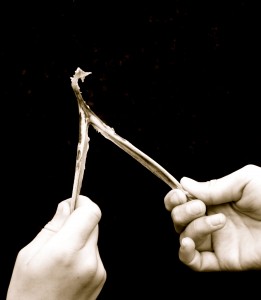
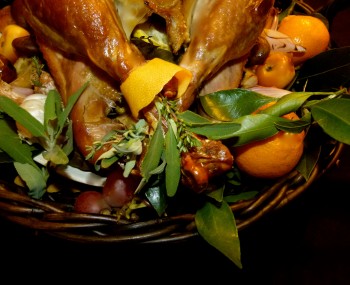
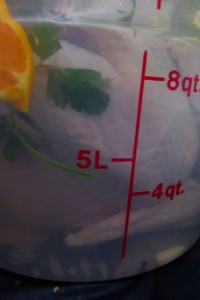
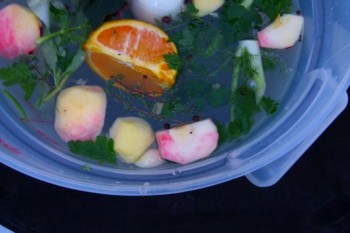
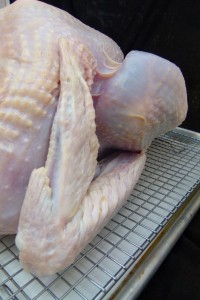
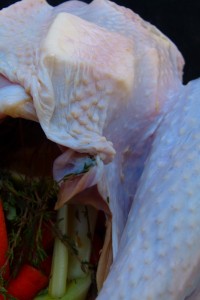
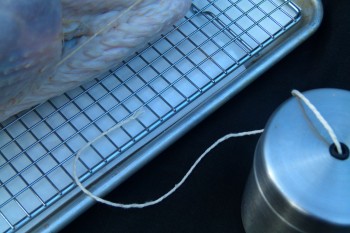
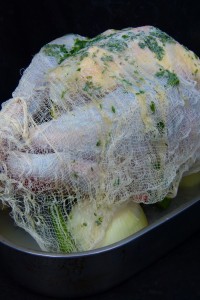
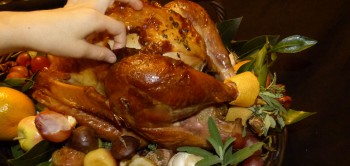
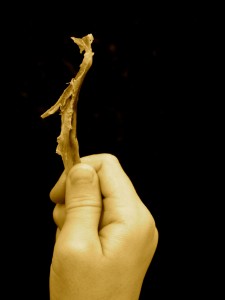



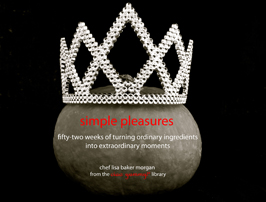



This is a life savor. I recently started following your blog and love your beautiful photos and the wonderful dishes. I have been cooking Turkeys for Thanksgiving for the past 4 years and never brined my turkey before. I am doing it right now. I feel more ready for this thanksgiving then ever before. thanks Chef Morgan!